

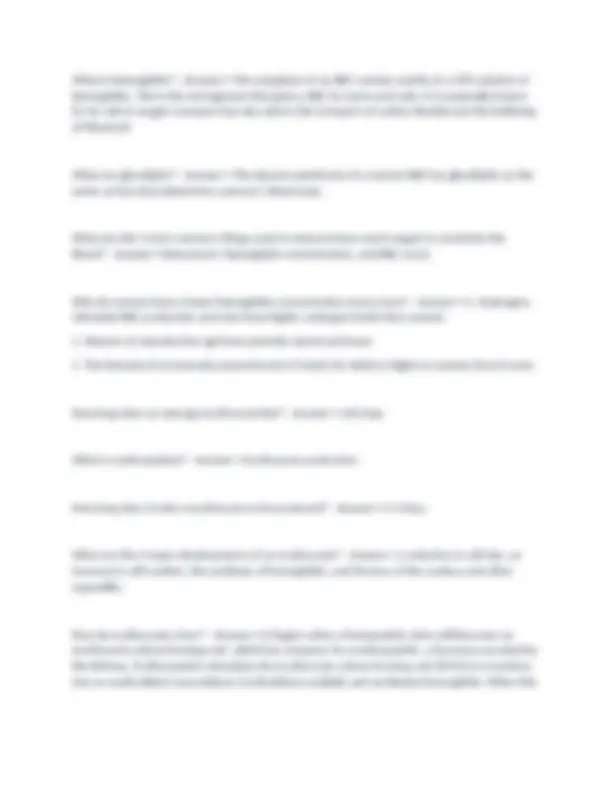
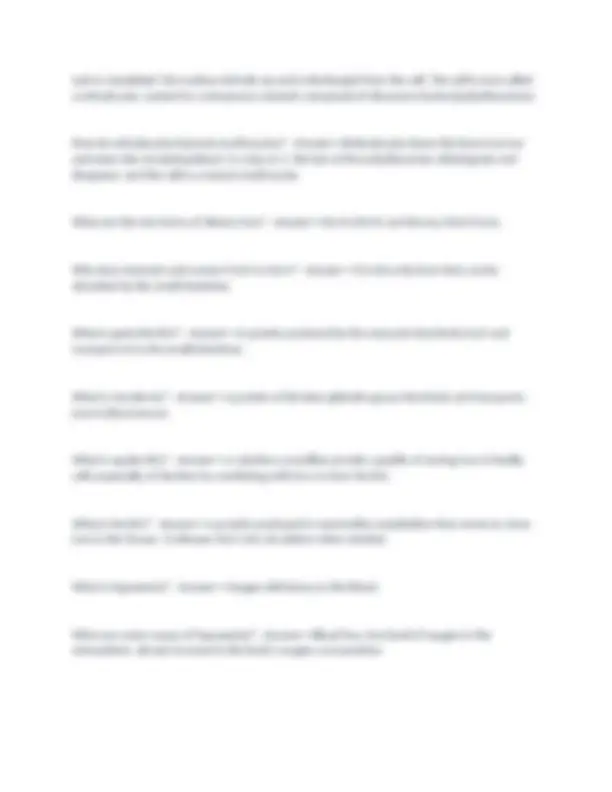
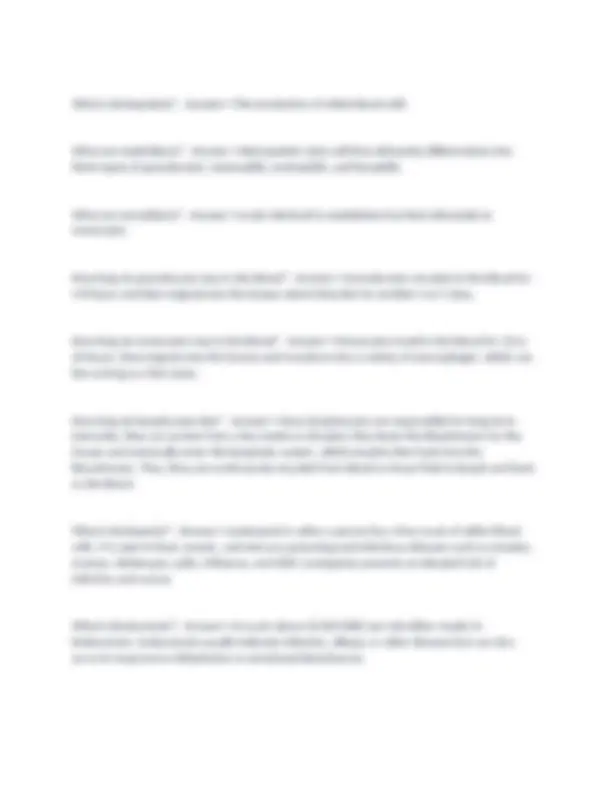
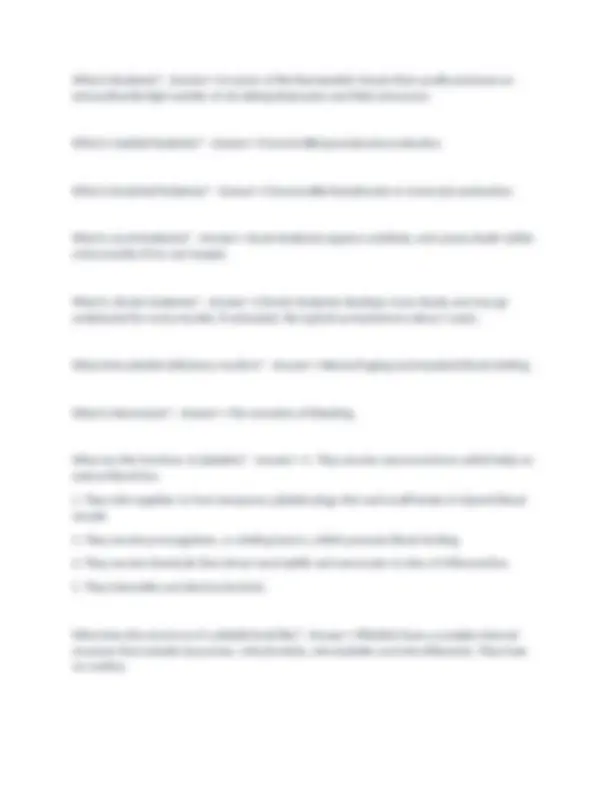
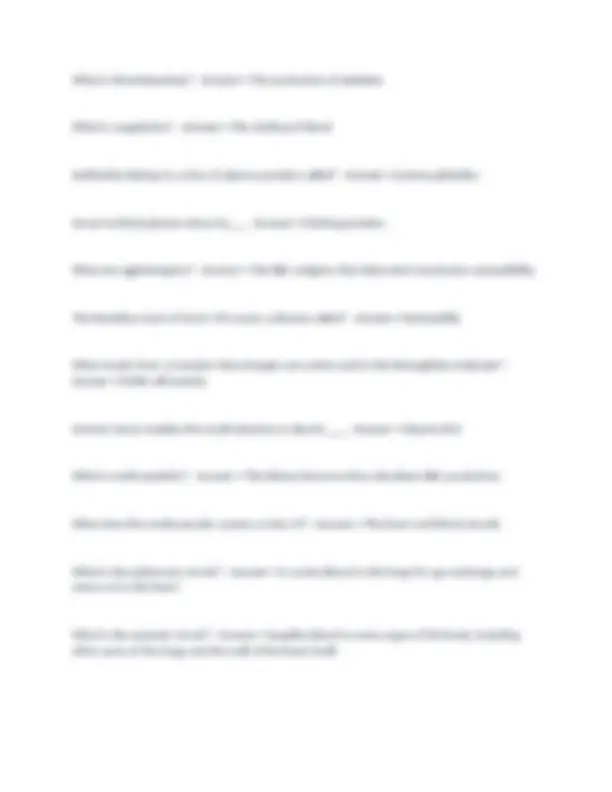
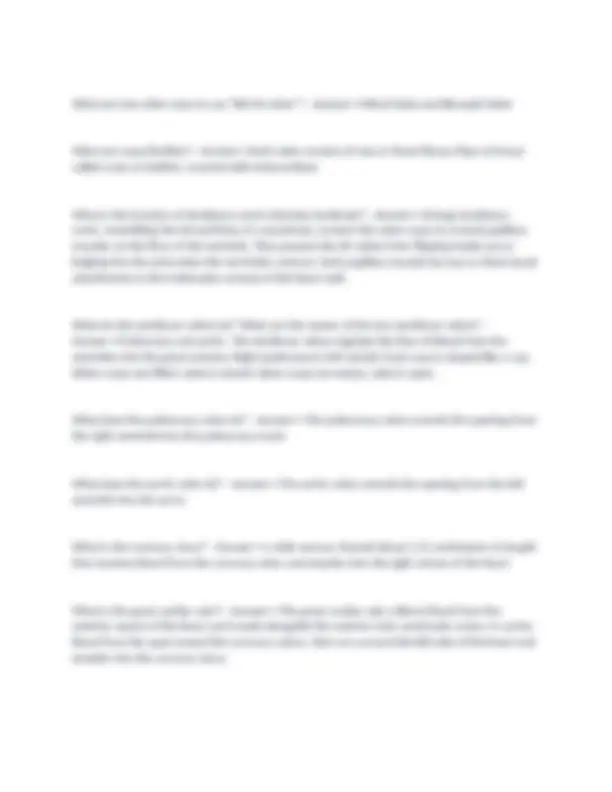
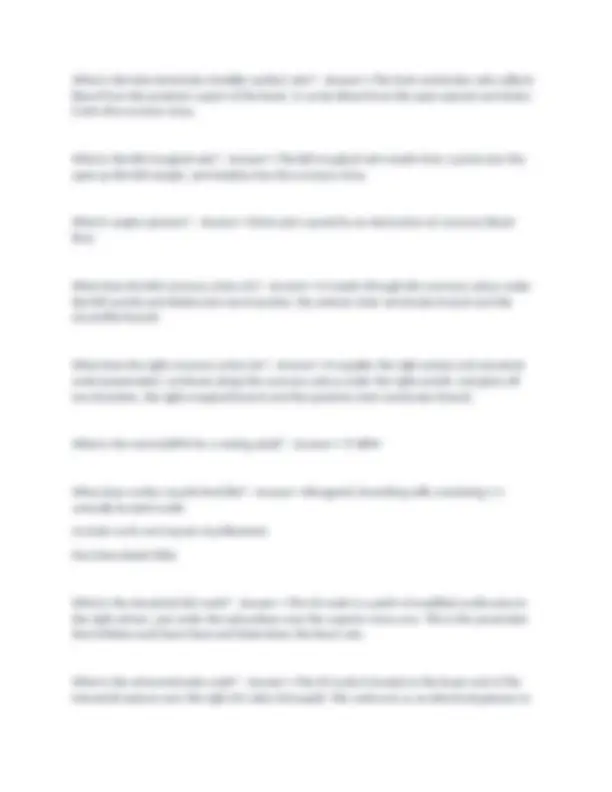
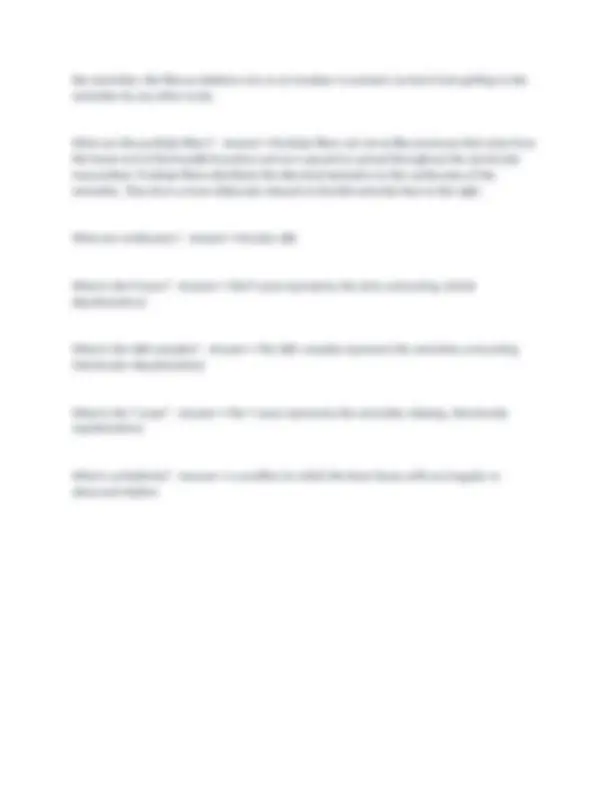


Study with the several resources on Docsity

Earn points by helping other students or get them with a premium plan


Prepare for your exams
Study with the several resources on Docsity

Earn points to download
Earn points by helping other students or get them with a premium plan
Community
Ask the community for help and clear up your study doubts
Discover the best universities in your country according to Docsity users
Free resources
Download our free guides on studying techniques, anxiety management strategies, and thesis advice from Docsity tutors
Anatomy & Physiology APHY 203 Fall Exam 1 2024 Final study guide Question and Answers What are the functions of blood? - Answer>>Transports gases, nutrients, and waste products (picks up nutrients from the digestive tract and delivers them to all of the body's tissues, carries metabolic waste to the kidneys for removal, carries hormones from endocrine cells to their target organs) Regulation of pH and osmosis Maintenance of body temperature Protection against foreign substances Clot formation
Typology: Exams
1 / 15

This page cannot be seen from the preview
Don't miss anything!










What are the functions of blood? - Answer>>Transports gases, nutrients, and waste products (picks up nutrients from the digestive tract and delivers them to all of the body's tissues, carries metabolic waste to the kidneys for removal, carries hormones from endocrine cells to their target organs) Regulation of pH and osmosis Maintenance of body temperature Protection against foreign substances Clot formation What is the normal pH of our body's tissues? - Answer>>7.35-7. What is the composition of blood (volume)? - Answer>>55% Plasma, Buffy Coat, 45% formed elements What is plasma composed of? - Answer>>7% proteins, 91% water, 2% other solutes (Ions, nutrients, waste products, gases, regulatory substances) What proteins are present in plasma? - Answer>>Albumins (58%), Globullins (38%), Fibrinogen (4%) Name the formed elements in blood. - Answer>>Platelets, white blood cells, red blood cells Name the different categories of white blood cells. - Answer>>Neutrophils, Lymphocytes, Monocytes, Eosinophils, Basophils
What percentage of the WBC are neutrophils? - Answer>>60-70% What percentage of the WBC are lymphocytes? - Answer>>20-25% What percentage of the WBC are monocytes? - Answer>>3-8% What percentage of the WBC are eosinophils? - Answer>>2-4% What percentage of the WBC are basophils? - Answer>>0.5-1% What are albumins? - Answer>>A protein found in blood plasma that controls blood viscosity and osmolarity. It is the smallest and most abundant protein. It transports fatty acids, free bilirubin, and thyroid hormones. What are globulins? - Answer>>A protein found in blood plasma responsible for solute transport (lipids and carbohydrates), clotting, and immunity. What is fibrinogen? - Answer>>Responsible for blood clotting What is the mean temperature of blood? - Answer>>38 C or 100.4 F What is the osmolarity of blood? - Answer>>280-296 mOsm/L What is the viscosity of blood? - Answer>>Whole blood: 4.5-5.5; plasma: 2. What is viscosity? - Answer>>The resistance of a fluid to flow. It is the thickness of a fluid. Oil is more viscous than water and honey is more viscous than oil.
What is hemoglobin? - Answer>>The cytoplasm of an RBC consists mainly of a 33% solution of hemoglobin. This is the red pigment that gives a RBC its name and color. It is especially known for its role in oxygen transport but also aids in the transport of carbon dioxide and the buffering of blood pH. What are glycolipids? - Answer>>The plasma membrane of a mature RBC has glycolipids on the outer surface that determine a person's blood type. What are the 3 most common things used to measure how much oxygen is carried by the blood? - Answer>>Hematocrit, hemoglobin concentration, and RBC count. Why do women have a lower hemoglobin concentration versus men? - Answer>>1. Androgens stimulate RBC production and men have higher androgen levels than women.
task is completed, the nucleus shrivels up and is discharged from the cell. The cell is now called a reticulocyte, named for a temporary network composed of ribosome clusters(polyribosomes). How do reticulocytes become erythrocytes? - Answer>>Reticulocytes leave the bone marrow and enter the circulating blood. In a day or 2, the last of the polyribosomes disintegrate and disappear, and the cell is a mature erythrocyte. What are the two forms of dietary iron? - Answer>>Ferric (Fe3+) and ferrous (Fe2+) ions. Why does stomach acid convert Fe3+ to Fe2+? - Answer>>It is the only form that can be absorbed by the small intestines. What is gastroferritin? - Answer>>A protein produced by the stomach that binds Fe2+ and transports it to the small intestines. What is transferrin? - Answer>>a protein of the beta globulin group that binds and transports iron in blood serum. What is apoferritin? - Answer>>a colorless crystalline protein capable of storing iron in bodily cells especially of the liver by combining with iron to form ferritin. What is ferritin? - Answer>>a protein produced in mammalian metabolism that serves to store iron in the tissues. It releases Fe2+ into circulation when needed. What is hypoxemia? - Answer>>Oxygen deficiency in the blood. What are some causes of hypoxemia? - Answer>>Blood loss, low level of oxygen in the atmosphere, abrupt increase in the body's oxygen consumption.
What is anemia? - Answer>>A deficiency of either RBCs or hemoglobin What causes anemia? - Answer>>Inadequate erythropoiesis or hemoglobin synthesis, hemorrhagic anemia from bleeding, hemolytic anemia from RBC destruction. What produces erythropoietin? - Answer>>Kidneys How is blood type determined? - Answer>>One's ABO blood type is determined by the hereditary presence or absence of antigens A and B on the RBCs. What are neutrophils? - Answer>>Antibacterial cells. What are eosinophils? - Answer>>It rises in allergies, parasitic infections, collagen diseases, and diseases of the spleen and the CNS. Basophils - Answer>>Basophils secrete two chemicals that aid in the body's defense processes: histamine, a vasodilator that widens the blood vessels, speeds the flow of blood to an injured tissue, and makes blood vessels more permeable so that blood components such as neutrophils and clotting proteins can get into the connective tissues more quickly; and heparin, an anticoagulant that inhibits clotting and thus promotes the mobility of other WBCs in the area. They also release chemical signals that attract eosinophils and neutrophils to sites of infection. Lymphocytes - Answer>>Immunization Monocytes - Answer>>Monocyte count rises in inflammation and viral infections. They transform into microphages. Which blood type is considered a universal donor? - Answer>>O negative Which blood type is considered a universal recipient? - Answer>>AB positive
What is leukopoiesis? - Answer>>The production of white blood cells What are myeloblasts? - Answer>>Hemopoietic stem cell that ultimately differentiates into three types of granulocytes; neutrophils, eosinophils, and basophils. What are monoblasts? - Answer>>Looks identical to myeloblasts but lead ultimately to monocytes. How long do granulocytes stay in the blood? - Answer>>Granulocytes circulate in the blood for 4-8 hours and then migrate into the tissues where they live for another 4 or 5 days. How long do monocytes stay in the blood? - Answer>>Monocytes travel in the blood for 10 to 20 hours, then migrate into the tissues and transform into a variety of macrophages, which can live as long as a few years. How long do lymphocytes live? - Answer>>Since lymphocytes are responsible for long-term immunity, they can survive from a few weeks to decades; they leave the bloodstream for the tissues and eventually enter the lymphatic system, which empties then back into the bloodstream. Thus, they are continuously recycled from blood to tissue fluid to lymph and back to the blood. What is leukopenia? - Answer>>Leukopenia is when a person has a low count of white blood cells. It is seen in lead, arsenic, and mercury poisoning and infectious diseases such as measles, mumps, chickenpox, polio, influenza, and AIDS. Leukopenia presents an elevated risk of infection and cancer. What is leukocytosis? - Answer>>A count above 10,000 WBC per microliter results in leukocytosis. Leukocytosis usually indicates infection, allergy, or other diseases but can also occur in response to dehydration or emotional disturbances.
What is thrombopoiesis? - Answer>>The production of platelets. What is coagulation? - Answer>>The clotting of blood Antibodies belong to a class of plasma proteins called? - Answer>>Gamma globulins Serum is blood plasma minus its___ - Answer>>Clotting proteins What are agglutinogens? - Answer>>The RBC antigens that determine transfusion compatibility. The hereditary lack of factor VIII causes a disease called? - Answer>>Hemophilia What results from a mutation that changes one amino acid in the hemoglobin molecule? - Answer>>Sickle cell anemia Intrinsic factor enables the small intestine to absorb ___ - Answer>>Vitamin B What is erythropoietin? - Answer>>The kidney hormone that stimulates RBC production. What does the cardiovascular system consist of? - Answer>>The heart and blood vessels What is the pulmonary circuit? - Answer>>It carries blood to the lungs for gas exchange and returns it to the heart. What is the systemic circuit? - Answer>>Supplies blood to every organ of the body, including other parts of the lungs and the wall of the heart itself.
What is the right side of the heart responsible for? - Answer>>The right half of the heart supplies the pulmonary circuit. It receives blood that has circulated through the body, unloaded its oxygen and nutrients, and picked up a load of carbon dioxide and other wastes. It pumps oxygen-poor blood into a large artery, the pulmonary trunk, which immediately divides into right and left pulmonary arteries. These transport blood to the air sacs (alveoli) of the lungs, where carbon dioxide is unloaded and oxygen is picked up. The oxygen rich blood then flows by way of the pulmonary veins to the left side of the heart. What is the left side of the heart responsible for? - Answer>>The left side supplies the systemic circuit. Blood leaves through the aorta and the aorta takes a sharp U-turn which is the aortic arch and passes downward, posterior to the heart. The aortic arch gives off arteries that supply the head, neck, and upper limbs. The aorta then travels toward the thoracic and abdominal cavities and issues smaller arteries to the other organs before branching into the lower limbs. After circulating through the body, the now deoxygenated systemic blood returns to the right side of the heart mainly through the superior and anterior vena cava. What does the heart do? - Answer>>1. Generate blood pressure
What are two other ways to say "left AV valve"? - Answer>>Mitral Valve and Bicuspid Valve What are cusps/leaflets? - Answer>>Each valve consists of two or three fibrous flaps of tissue called cusps or leaflets, covered with endocardium. What is the function of tendinous cords (chordae tendinae)? - Answer>>Stringy tendinous cords, resembling the shroud lines of a parachute, connect the valve cusps to conical papillary muscles on the floor of the ventricle. They prevent the AV valves from flipping inside out or bulging into the atria when the ventricles contract. Each papillary muscle has two or three basal attachments to the trabeculae carneae of the heart wall. What do the semilunar valves do? What are the names of the two semilunar valves? - Answer>>Pulmonary and aortic. The semilunar valves regulate the flow of blood from the ventricles into the great arteries. Right (pulmonary); left (atrial). Each cusp is shaped like a cup. When cusps are filled, valve is closed; when cusps are empty, valve is open. What does the pulmonary valve do? - Answer>>The pulmonary valve controls the opening from the right ventricle into the pulmonary trunk. What does the aortic valve do? - Answer>>The aortic valve controls the opening from the left ventricle into the aorta. What is the coronary sinus? - Answer>>a wide venous channel about 2.25 centimeters in length that receives blood from the coronary veins and empties into the right atrium of the heart. What is the great cardiac vein? - Answer>>The great cardiac vein collects blood from the anterior aspect of the heart and travels alongside the anterior inter ventricular artery. It carries blood from the apex toward the coronary sulcus, then arcs around the left side of the heart and empties into the coronary sinus.
What is the interventricular (middle cardiac) vein? - Answer>>The inter ventricular vein collects blood from the posterior aspect of the heart. It carries blood from the apex upward and drains it into the coronary sinus. What is the left marginal vein? - Answer>>The left marginal vein travels from a point near the apex up the left margin, and empties into the coronary sinus. What is angina pectoris? - Answer>>Chest pain caused by an obstruction of coronary blood flow. What does the left coronary artery do? - Answer>>It travels through the coronary sulcus under the left auricle and divides into two branches; the anterior inter ventricular branch and the circumflex branch. What does the right coronary artery do? - Answer>>It supplies the right atrium and sinoatrial node (pacemaker), continues along the coronary sulcus under the right auricle, and gives off two branches, the right marginal branch and the posterior inter ventricular branch. What is the normal BPM for a resting adult? - Answer>>75 BPM What does cardiac muscle look like? - Answer>>Elongated, branching cells containing 1- centrally located nuclei Contains actin and myosin myofilaments Has intercalated disks What is the sinoatrial (SA) node? - Answer>>The SA node is a patch of modified cardiocytes in the right atrium, just under the epicardium near the superior vena cava. This is the pacemaker that initiates each heart beat and determines the heart rate. What is the atrioventricular node? - Answer>>The AV node is located at the lower end of the interatrial septum near the right AV valve (tricuspid). This node acts as an electrical gateway to